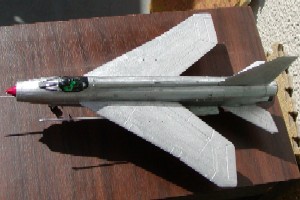As empty as the Sky
Extra: The
Origine of species
When I was younger, so much younger than today, or I should
say in my childhood, I had a very favorite TV program originally
filmed in the U.K. In the programme, future aircrafts play active
and important roles and I was so absorbed. Today, in the eyes
with some knowledge of aviation history, the aircrafts (or
rockets) seem to have similar shapes to ones operated by the
Royal Air Force at that time.
Please compare and find the similarity: the images below are
plastic-models that I assembled myself. For real-existed
aircrafts, I tried to paint as similar as each counterpart, so I
think that the Royal Air Force has never adopted these colour
schemes.
Oh, sorry, I have mot told you the name of the TV programme
yet. It is the "Thunderbirds."
 |
BAe (English
Electric) Lightning F6 Length: 16.84m Span: 10.62m Height: 5.97m
Wing area: 44.1sq.m Weight (Empty): 13,430kg
Engine: Rolls Royce Avon 301
Thrust: 7,420kg x 2
Max Speed: Mach 2.27
Cruising Speed: 595mph
Climbing rate: 15,240m/min
Range: 1,280km
|
 |
Thunderbird
1 Length: 35.05m Span: 24.48m
Height: 18.29m
Engines: Rolls Royce Atomic Ram Jet x 5
Vertical-Lift Rocket x 1
Max speed: Mach 21
Cruising Speed: Mach 10
|
 |
De
Havilland Vampire FB.5 Length: 9.36m Span: 11.57m Height: 2.69m
Engine: De Havilland Goblon 2
Thrust: 1,406kg x 1
Max Speed: 861km/h (535mph)
|
 |
Thunderbird
2 Length: 76.20m Span: 54.80m Height:
18.29m
Weight (empty): 180.3t Max Payload: 120t
Engines: Rolls Royce Atomic Ram Jet x 2
Vertical-Lift Rocket x 2
Max Speed: Mach 7
|
To index



